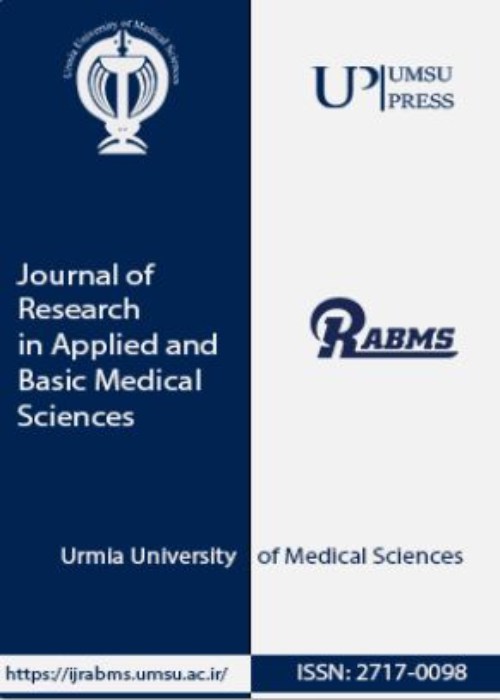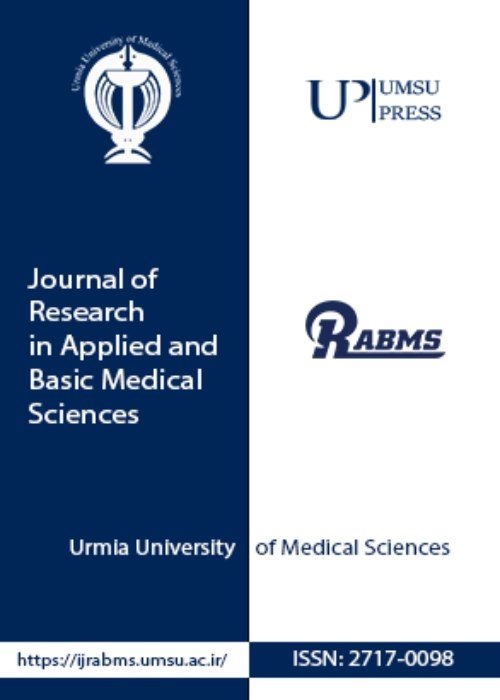فهرست مطالب

Journal of Research in Applied and Basic Medical Sciences
Volume:8 Issue: 3, Summer 2022
- تاریخ انتشار: 1401/04/10
- تعداد عناوین: 8
-
Pages 110-117Background & Aims
carbapenem-resistant strains of Acinetobacter baumannii (A. baumannii) have been reported worldwide over the last decade. Detection of the carbapenemases is crucial to determine the severity of the problem. The aim of our study was to detect Carbapenemase and MBL producing strains among Multidrug Resistant (MDR) Acinetobacter species isolated from clinical specimens in this geographical area by Modified Hodge test (MHT) and Imipenem-EDTA double disc synergy test and their evaluation.
Materials & MethodsIn this descriptive-prospective study, consecutive, non-duplicate, and resistant-to-carbapenems clinical strains of Acinetobacter species isolated from various clinical samples were included. Antimicrobial sensitivity of Acinetobacter isolates was performed on Mueller Hinton agar plates by Kirby-Bauer disk diffusion method. Carbapenemase production was confirmed by MHT. Confirmation of MBL production was done by subjecting all isolates with positive screen test to combined disc test using imipenem, meropenem, and EDTA. Data analysis was done using Epi Info 7.0. Categorical variables were summarized as frequency and percentage and continuous variables as Mean and SD.
ResultsA total of 312 non-duplicate strains of A. baumannii were isolated, out of which 224 (71.79%) strains were resistant and 88 (28.21%) were sensitive to carbapenem. There was 100% sensitivity to Colistin followed by Tigecycline (79%) whereas high degree of resistance was seen against 2nd and 3rd generation cephalosporins and quinolones (>90%). 82.6% were identified as carbapenemase producers on MHT and on Imipenem-EDTA combined disc test (CDT), 21.4% were found to be positive.
ConclusionOur study showed that tests like MHT are equally efficient to detect carbapenemase production, followed by Imipenem-EDTA combined disc test. These tests are cost-effective and easy to perform and may be used routinely to assess whether carbapenemase producers are present or not.
Keywords: Acinetobacter, carbapenems, Modified Hodge Test, Imipenem-EDTA Combined Disc Test -
Pages 118-127Background & Aims
Methotrexate despite its beneficial anti-cancer and immunosuppressant effects has continued to receive limitation in usage due to its organ toxicity. The aim of this study was to investigate the nephroprotective effect of aqueous leaf extract of Chromolaena odorata on Methotrexate-induced injury and damage on kidney in rat.
Materials & MethodsThe study consisted of four groups of rats: Control, Chromolaena odorata extract, Methotrexate, and Methotrexate+Chromolaena odorata extract groups. Chromolaena odorata extract was given orally (200 mg/kg) for 10 days, and Methotrexate at a single dose (20 mg/kg) was administered intraperitoneally on day 9 of the experiment. Blood and kidney were collected on day 11 to measure biochemical, hematological and oxidative stress parameters as well as histopathological analysis.
ResultsMethotrexate administration when compared to control and extract, treated rats decreased antioxidant agents, including catalase (CAT) and Superoxide dismutase (SOD) while it increased the Malondialdehyde level in the kidney tissues. Methotrexate also increased Urea and Creatinine in the blood samples. The result also showed that Methotrexate administration produced a significant decrease in Hemoglobin (HB), White Blood Cell (WBC), Hematocrit (HCT), Red Blood Cell (RBC), Platelets (PLTS), Lymphocyte, Basophil, and Monocyte when compared to control and all extract administered rats. The result of histopathological analysis of the kidney revealed that Methotrexate administration caused necrosis of renal tubules, renal congestion, renal tubule epithelium swelling, interstitial hemorrhage, glomerular atrophy, as well as dilatation. Chromolaena odorata extract administration significantly alleviated kidney function, improved antioxidant parameters, decreased levels of oxidative stress agents, restored the hematological parameters towards normalcy as well as resulted in noticeable improvement and attenuation toward normalcy in the kidney structure, and thus, remarkably preventing Methotrexate-induced tissue injury and damage.
ConclusionThe observed data showed that Chromolaena odorata had a protective effect against Methotrexate-induced nephrotoxicity by maintaining the activity of the antioxidant defense system, which can be attributed to its bioactive constituents.
Keywords: Antioxidants, Chromolaena Odorata, Kidney, Methotrexate, Oxidative Stress -
Pages 128-136Background & Aims
Abortions, ectopic pregnancy, and molar pregnancy are the common causes of bleeding during the first trimester. Current study evaluated the first trimester bleeding and prognosticate and predict the status of abnormal pregnancies using ultrasound scan.
Materials & MethodsIn this observational study, total 100 pregnants of aged from 22 to 34 years with first-trimester vaginal bleeding were examined by Ultrasonography. Demographics, obsestric history such as age, parity, gravidity bleeding severity, ultrasonography results, and clinical diagnosis referred in categorical data and analysed using Chi-square analysis. Statistical analyses were done by SPSS ver. 24.
ResultsSpotting in 40%, light in 28%, and heavy in 32% of the pregnants in heaviness of bleeding. 73% of pregnant reported spontaneous bleeding. Threatened abortion clinically diagnosed in 52 cases; Ultrasonography confirmed 24 pregnant as threatened abortions and aids in correctly diagnosing 8 cases that were missed on clinical examination. 24 pregnant women out of 36 threatened abortions were continued to term, with a 66 % success rate. Ultrasonography correctly diagnosed pregnant women who were threatened with abortion (n=36), incomplete abortion (n=20), missed abortion (n=8), ectopic (n=8), inevitable abortion (n=8), blighted ovum (n=4), and Hydatidiform mole (n=4). 96 out of 100 pregnants were correctly diagnosed by Ultrasound when compared to 72 out of 100 cases on the basis of clinical diagnosis with a disparity of 64%. On follow-up, six cases of threatened abortion were terminated.
ConclusionUltrasonography plays an important role in the etiological diagnosis of bleeding in the first trimester of pregnancy; in most cases, a responsible abnormality of bleeding is easily identified. Using Ultrasonography, misdiagnosis at first trimester can be avoided.
Keywords: Ultrasonography, First Trimester Bleeding, Accuracy, Blighted Ovum -
Pages 137-144
Development of human brain is the essential process in the prenatal period of human growth. The total surface of human brain area is 1820 cm2, and the average cortical thickness is 2.7 mm. We reviewed and referred to several articles in this field. Comparative studies of the primate's brain show that there are general architectural basis governing the brain growth and evolutionary development. In this study, it is discussed about the human brain development with highlighting on the main mechanisms in the embryonic stage and early postnatal life as well as the general architectural values in brain evolution from primates to now. It is suggested that neurodevelopment involves some genetic bases in the neural stem cells proliferation, cortical neurons migration, cerebral cortex folding, synaptogenesis, gliogenesis, and myelination of neural fibers.
Keywords: Neurodevelopment, Brain Evolution, Prenatal Stage, Primate -
Pages 145-149
The radial artery is useful in interventional treatment, and its variation is important for the clinician consideration. During the dissection of Sudanese adult 83-old-male cadaver, multiple upper limbs, a rare vascular variation, was observed in cases 1 & 2. The axillary arteries in both limbs showed a pattern of many variations, the radial arteries have been arising directly from their second part in the axilla. They were run through the arm superficially, along with their courses, they were separated from the brachial artery. In the right limb, a communicated artery was seen connecting the radial and brachial arteries at the region of the cubital fossa. However, their courses of the radial artery in the forearm and hand were found normal. Knowledge of anatomical variation of the radial artery is essential in performing the transradial coronary procedure.
Keywords: Radial Artery, Axillary Artery, Variation, Cadaver -
Pages 150-160Background & Aims
Long course of the radial nerve and its proximity to the humerus makes Radial Nerve (RN) prone to injury in diaphyseal fractures. In an effort to maintain its integrity, soft tissue landmarks can be readily made use of to provide facile nerve identification, as osseous landmarks might get altered in fractures. The aim of this study was to provide an idea of safe zone for securing radial nerve in relation to soft tissue structures and thereby, preventing the concomitant iatrogenic injury.
Materials & Methods40 Upper limb specimens from 20 cadavers were dissected. The radial nerve was identified proximal to the apex of Tricipital aponeurosis (TA) in posterior arm, at the level of entry into the lateral inter muscular septum and along the lateral border of TA. The mean distance between the radial nerve and aponeurosis was measured at all the three sites to find the safe zone for securing the radial nerve during surgeries.
ResultsThe radial nerve was found proximally from the medial apex of tricipital aponeurosis at a distance of 43.49 ± 6.67 mm (range 30.34-55.72 mm) within the muscle belly of triceps. The minimal permissible distance for the triceps split was 3.03 cm from the medial apex for both right and left arms. The distance of above 15 mm (range from 15.56 to 47.47mm) from the lateral border of tricipital aponeurosis was considered as a safe zone and no branches of the radial nerve were found in this zone. Radial nerve was identified along its course in the range of 15.56 to 47.47 mm from the lateral border of TA and this should be taken into consideration by the operating surgeon.
ConclusionThe Tricipital aponeurosis is a useful soft tissue landmark to secure the radial nerve safely throughout its course in the arm. Knowledge of safe and dangerous zones of the radial nerve would help the orthopedic surgeons to avoid the risk of iatrogenic nerve injury, which is not an uncommon phenomenon.
Keywords: Musculo-Aponeurotic Landmarks, Radial Nerve, Anatomical Dissection, Humeral Fracture -
Pages 161-168
Leishmaniasis is a neglected disease that affects more than 12 million people worldwide. After parasite inoculum by female blood-sucking insects, e.g. Phlebotomus, neutrophils quickly infiltrate and phagocytes Leishmania parasites. Macrophages are the second immune cells. They possess several pattern recognition receptors that respond to different surface molecules such as Lipophosphoglycan, glycoprotein 63 (GP63), PPG, GIPL, CP, and SAP. It was found that Leishmania GP63 cleaves several targets of infected macrophages, including the myristoylated alanine-rich C kinase substrate, p130CAS, PEST, NF-B, and AP-1. After activation of surface molecules, lipid metabolites of arachidonic acid, including leukotrienes and prostaglandins, are important mediators in Leishmaniasis. These lipid metabolites can be metabolized by different enzymes, including the cyclooxygenase and lipoxygenase.
Keywords: Leishmaniasis, Glycoprotein 63, Surface Molecules -
Pages 169-174Background & Aims
Cervical cancer is the fourth most common cancer among women worldwide. Pap smear testing can detect cervix precursor lesions early and reduce the morbidities and mortalities associated with cervical cancer by its early detection. The aim of this study was to analyze 100 Papanicolaou smears (PAP smears) taken from women presenting various gynecological indications as a screening method to rule out cervical cancer.
Materials & MethodsPAP smear samples were collected using Ayres spatula devices from 100 women between the ages of 25 and 70 who reffered to the Gynecological Outpatient Department with different gynecological complaints. Smear reports were reported as per the 2013 Bethesda system.
ResultsThe common presenting complaints of women in our study were abnormal vaginal discharge (p/v 55%), followed by pruritities valve (9%), intermenstrual bleeding (8%), and postcoital bleeding (2%). On speculum examination of the cervixes, 30% had chronic cervicitis. Cervix bleeds on touch in only 4% of the women. Abnormal vaginal discharge is seen in 60% of women. 36% of smears were inflammatory, 5% had low-grade squamous intraepithelial lesions, and 2% had high-grade squamous intraepithelial lesions. ASCUS and ASC-H were reported in 3% and 1% of the smears, respectively.
ConclusionPAP smear is a very easy and economical screening method to detect premalignant and malignant lesions of the cervix, which helps in proper treatment.
Keywords: PAP Smear, High Grade Squamous Intraepithelial Lesions, Low Grade Squamous Intraepithelial Lesions, Atypical Squamous Cells, Undetermined Squamous Cell Carcinoma


